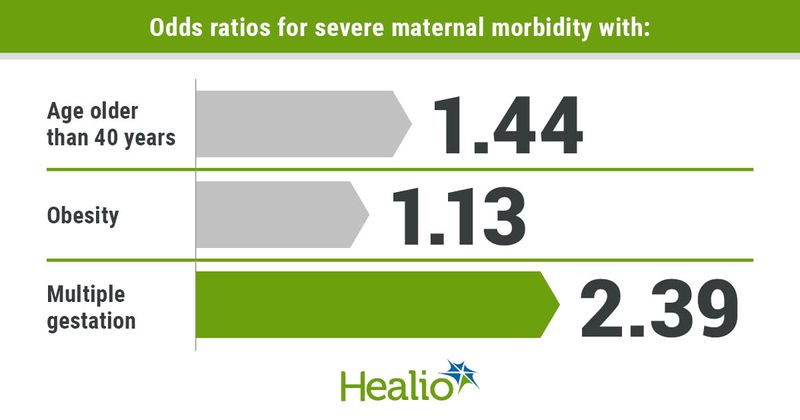Maternal morbidity increases in Scotland, halting decreases in maternal mortality rate
The rate of severe maternal morbidity in Scotland increased between 2012 and 2018, and was associated with age, BMI, multiple gestation and mode of delivery, data showed.
During that time, the rate of maternal mortality plateaued, suggesting the increasing rate of severe morbidity has halted years of progress at improving survival. That the maternal mortality rate has not reversed direction and increased only shows that providers are adapting to meet the needs of a complex patient population, according to researchers.

“The rate of severe maternal morbidity may be increasing in some high-income countries, which is associated with modifiable factors such as obesity, and other factors that, whilst not modifiable, might trigger intervention, such as age and previous caesarean delivery,” John A. Masterson, BMedSci(Hons), a medical student at the University of Edinburgh in Scotland, and colleagues wrote in Anaesthesia. “The increasing prevalence of these factors in U.K. mothers might reverse the historical reductions in mortality and will increase health care during pregnancy and childbirth.”
Masterson and colleagues analyzed a cohort of 762,918 pregnancies with a recorded live birth, stillbirth or late second trimester loss between Jan. 1, 2005, and Dec. 31, 2018, that were registered in Scottish databases. They examined the incidence of severe maternal morbidity (SMM) in patients’ records from conception through 42 days postpartum.
Incidence of SMM
In total, there were 9,345 incidents of SMM among 7,947 pregnancies, and the incidence of SMM increased from nine to 17 per 1,000 pregnancies between 2012 and 2018. Puerperal sepsis was the most common morbidity (30%) and partly accounted for the increase in SMM starting in 2012. However, the researchers noted that the rate of SMM — which was higher than rates established in previous studies — could possibly be attributed to the inaccurate coding of sepsis in the databases they used.
The likelihood of SMM was higher for women aged 35 to 39 years (OR = 1.22; 95% CI, 1.13-1.33) and for women aged older than 40 years (OR = 1.44; 95% CI, 1.27-1.63) compared with those aged 25 to 29 years. Additionally, women with obesity, or a BMI of 30 kg/m2 to 40 kg/m2, had greater odds of SMM compared with women with normal weight, or a BMI of 18.5 kg/m2 to 24.9 kg/m2 (OR = 1.13; 95% CI, 1.06-1.21), as did women with extreme obesity, or a BMI of more than 40 kg/m2 (OR = 1.32; 95% CI, 1.15-1.51). The odds of SMM also were higher with multiple gestation (OR = 2.39; 95% CI, 2.09-2.74), previous cesarean delivery (OR = 1.52; 95% CI, 1.4-1.65) and maternal birth in Africa or the Middle East.
Compared with women who did not have SMM, those who did had longer hospital stays (2 days vs. 3 days) and a higher rate of maternal mortality (1.6 vs. 365 per 100,000 pregnancies). Although the rate of maternal mortality was higher among women with SMM, the national maternal mortality rate stayed stable.
“The reality today is that the increasing complexity of health care needs of women during pregnancy means that they may need greater levels of care during pregnancy and delivery,” the researchers of the Scottish study said in a press release. “The fact that maternal mortality has stalled, rather than increased, suggests maternity services are adapting to these many challenges.”
Parallels in the United States
Data published in February by the CDC National Center for Health Statistics showed that maternal mortality rates continue to rise in the U.S., increasing from 754 deaths in 2019 to 861 deaths in 2020. Similar to the findings of Masterson and colleagues, this rate was driven in part by older maternal age.
The elevated rate of maternal mortality among non-Hispanic Black and Hispanic women also drove the rate of maternal mortality among all races and ethnicities in the U.S., CDC data showed.
Despite this, some states such as California have implemented practices that are reducing maternal mortality rates, according to an article in the Journal of Public Health Policy. One of these practices included funding programs to address social factors — such as race — that impact maternal health, which the study authors suggested should be expanded to the entire country.
References:
- Hoyert DL. NCHS Health E-Stats. 2022;doi:10.15620/cdc:113967.
- Increasing maternal age, obesity and caesarean section rates could be reasons why maternal mortality is no longer falling in the UK. https://www.eurekalert.org/news-releases/958468. Published July 12, 2022. Accessed July 18, 2022.
- Masterson JA, et al. Anaesthesia. 2022;doi:10.1111/anae.15798.
- Nichols CR, et al. J Public Health Policy. 2020;doi:10.1057/s41271-020-00264-9.










